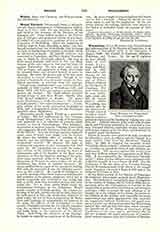

Wessenberg, IGNAZ HEINRICH VON, Vicar-General and Administrator of the Diocese of Constance, b. at Dresden, November 4, 1774; d. at Constance, August 9, 1860. He studied at Augsburg, Dillingen, Würzburg, and Vienna. At the age of eighteen he was already canon at Constance, Augsburg, and Basle, and in 1802, when still a sub-deacon he became Vicar-General of Prince-Primate Dalberg for the Diocese of Constance. Not until 1812, when he was thirty-eight years old, did he accept priest’s orders. Wessenberg was entirely unfit for the position. Though a man of extensive knowledge, he was not a profound scholar and his theological training was very deficient. Imbued from his early youth with Josephinistic and Febronian principles, he advocated a German National Church, somewhat loosely connected with Rome, supported by the State and protected by it against papal interference.
Before he became vicar-general he had ventilated his liberalistic views of religion and the Church in a work entitled “Der Geist des Zeitalters” (Zurich,1801). In 1802 he founded the monthly review “Geistliche Monatsschrift”, which he edited and used as a medium to spread his ideas of false religious enlightenment. The protests against this review were such that Dalberg ordered its suspension on May 25,1804. It was replaced by the “Konstanzer Pastoralarchiv”, which was less offensive and continued to be published annually in two volumes till 1827. For the realization of his pet plans of a National German Church Wessenberg made futile efforts at the council which Napoleon convened in Paris in 1811 and at the Congress of Vienna in 1815.
In the Swiss portion of the Diocese of Constance Wessenberg’s innovations aroused great dissatisfaction. His abolition of various holy days of obligation in the cantons of Aargau and St. Gall in 1806; his cooperation with the Government of Lucerne in the suppression of monasteries; his orders in case of mixed marriages (1808) to permit the male offspring to be brought up in the religion of the father, the female in the religion of the mother; and especially his many matrimonial and other dispensations that exceeded his competence induced Testiferrata, the papal nuncio at Lucerne, to call him to account, but Wessenberg insisted that nothing had been done which exceeded the jurisdiction of the Bishop of Constance, giving Testiferrata at the same time to understand that he did not recognize the papal nunciature of Lucerne. After various requests from the Catholics of Switzerland, Pius VII put an end to Wessenberg’s reformatory plans in that part of the diocese by severing the Swiss cantons from the Diocese of Constance, in a Brief of October 21, 1814. On November 2 of the same year the pope ordered Dalberg to depose Wessenberg without delay from the office of vicar-general. Dalberg kept the pope’s order secret, though in the beginning of 1815 he temporarily replaced Wessenberg as vicar-general by Canon von Roll for private reasons. In the summer of 1815 he requested the Government of Baden to appoint Wessenberg his coadjutor with the right of succession. The Government acceded to Dalberg’s wish, but Rome refused to recognize the coadjutorship. In the same year Wessenberg published anonymously a notorious anti-papal treatise entitled “Die deutsche Kirche. Ein Vorschlag zu ihrer neuen Begrundung and Einrichtung”. It is a plea for his scheme of a German National Church, and suggests detailed plans as to its organization. On February 17, 1817, seven days after the death of Dalberg, the Chapter of Constance elected Wessenberg as vicar of the chapter and administrator of the diocese, but his election was invalidated by Pius VII in a Brief of March 15, 1817. In July Wessenberg went to Rome, hoping to gain the pope to his side and return as primate of his projected German Church or, at least, as Bishop of Constance. He was kindly received by Consalvi, the secretary of state, but was told that, before the pope would enter into any negotiations with him, he would have to resign as administrator and, like Fenelon, make a declaration to the effect that he disapproved all that the pope disapproves. Refusing to submit to these conditions, he left Rome and with the approval of the Government of Baden continued to act as administrator of Constance until 1827, in open disobedience to the pope. Pius VII suppressed the Diocese of Constance in his Bull, “Provida sollersque”, of August 16, 1821, incorporating it in the newly erected Archdiocese of Freiburg, whose first archbishop, Bernard Boll, was appointed in 1827. It must be said to the credit of Wessenberg that during his administration he rendered some services to the Church. Among these are especially noteworthy his deep solicitude for a better training and stricter discipline of the clergy and his insistence on regular Sunday sermons in parish churches and semi-weekly religious instructions in the state schools. After his retirement in 1827 he gave vent to his anti-papal sentiments and spread his rationalistic views on religion and the Church by various treatises and by frequent contributions to the anti-religious review, “Die freimuthigen Blatter” (Constance, 1830-44). His chief literary productions are: “Die grossen Kirchenversammlungen des 15. und 16. Jahrhunderts in Beziehung auf Kirchenverbesserung” (4 vols., Constance, 1840, 2nd ed., 1845), extremely anti-papal (cf. Hefele, in “Tubinger Quartalschrift”, 1841, 616 sq.); “Die Stellung des romischen Stuhles gegenuber dem Geiste des 19. Jahrhunderts” (Zurich, 1833); “Die Bisthumssynode und die Erfordernisse und Bedingungen einer heilsamen Herstellung derselben” (Freiburg, 1849). The last-named two works were placed on the Index. He is also the author of a collection of poems (7 vols., Stuttgart, 1843-54).
MICHAEL OTT

